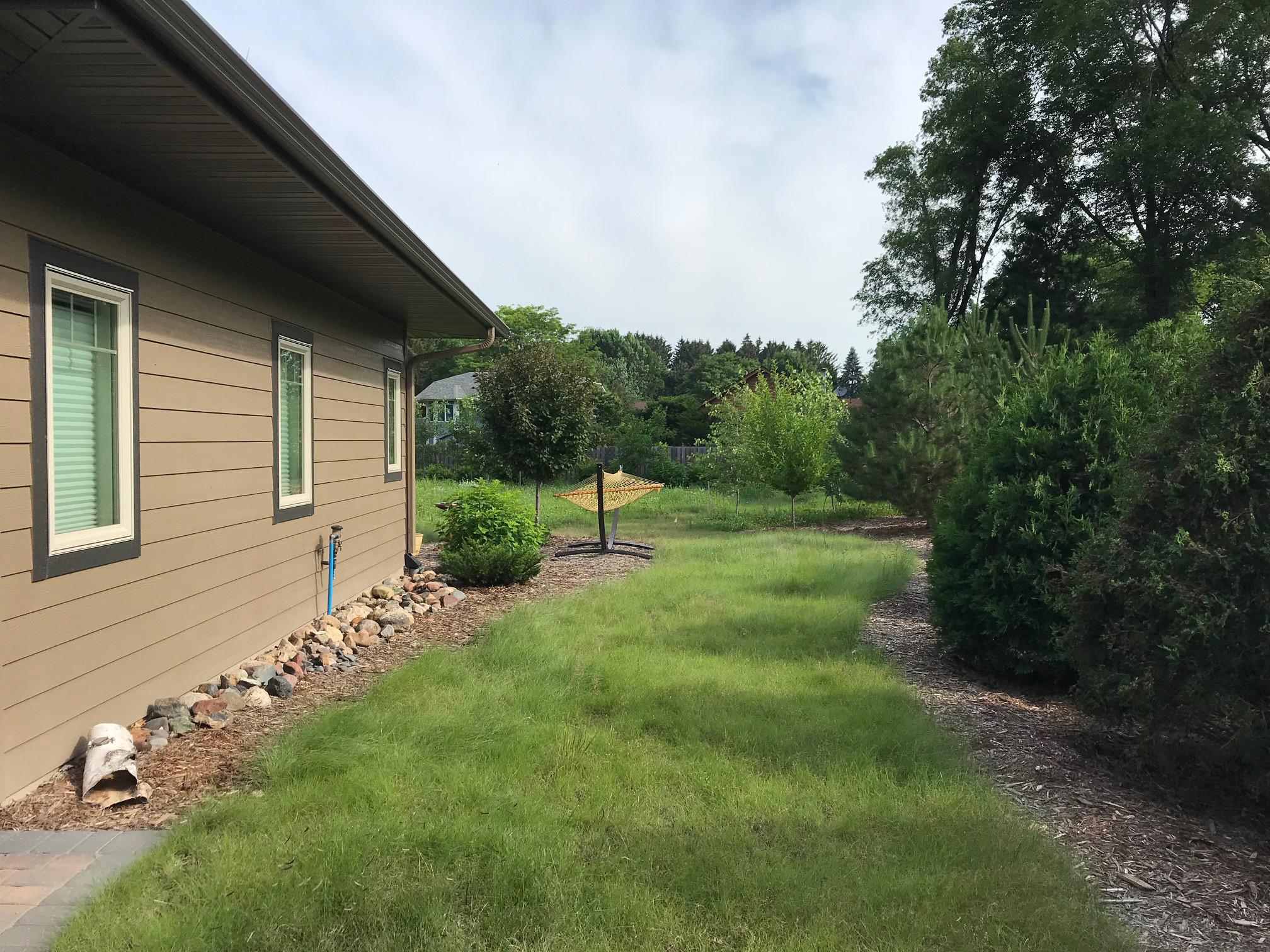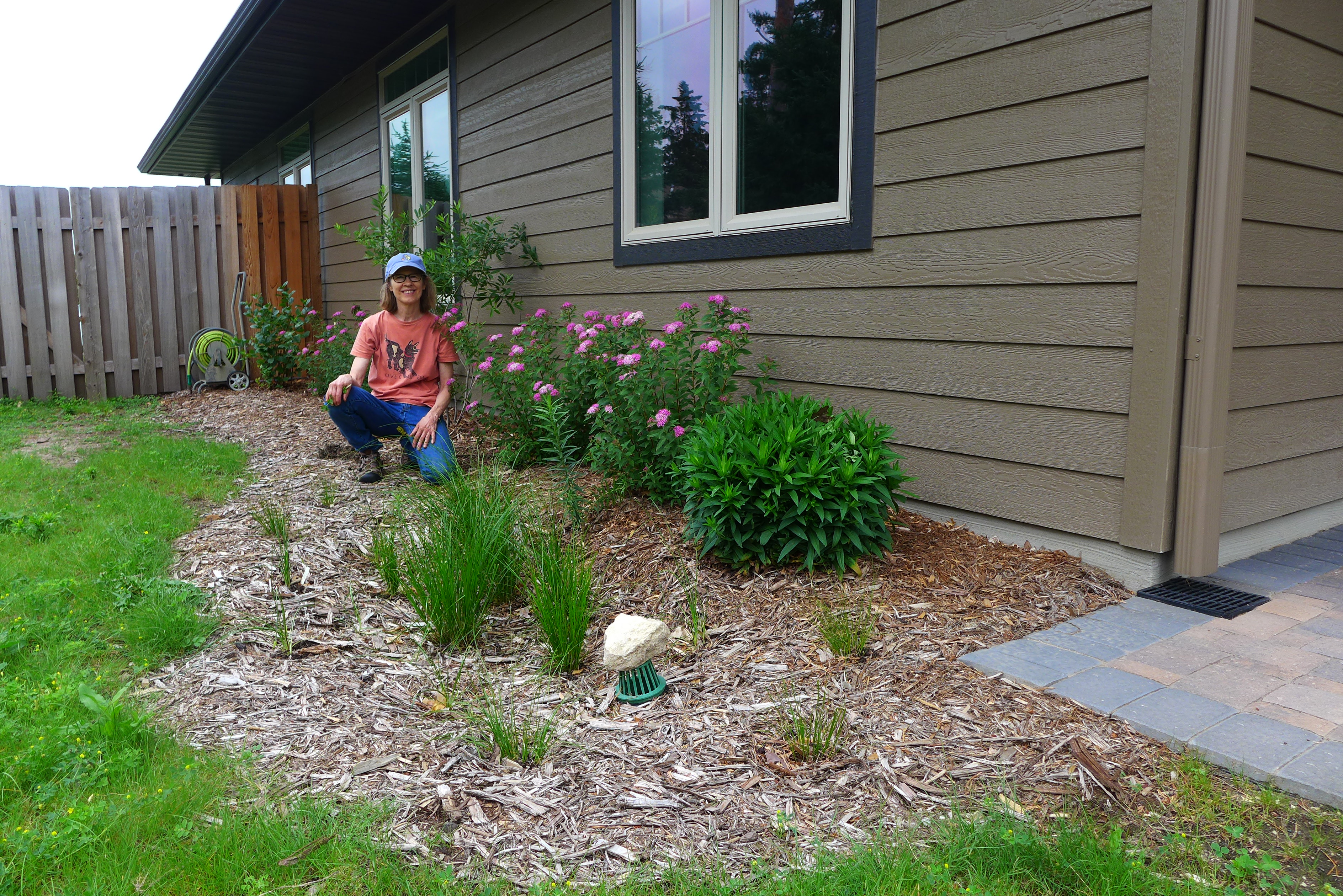Neighborhood Spotlight: Sharon and Peter
VADNAIS HEIGHTS—To Sharon Lorraine and Peter Helgeson, building a new home on a vacant lot was an opportunity for the home and the yard. Having been through the routine of a conventional lawn at a previous home, they had a vision to bring nature close to home while still being practical, conserving water, and saving time and money compared to conventional landscaping. Planning with a landscape architect and getting support from VLAWMO cost-share funds, the result included about thirty native trees, a wide variety of native shrubs, four raingardens, three rain barrels, a native prairie/savannah, and a lo-mow lawn. This was a new experience for both Sharon and Peter, who were excited but a little nervous to step into an entirely different yard routine. VLAWMO was fortunate to hear about their progress since the project was installed in 2016.
Landscape Chat with Sharon and Peter:
What do you enjoy most about your multiple yard projects?
What we’ve most enjoyed is supporting nature and experiencing it close-up. Besides getting the trees established there really isn’t any watering needed. Besides monarchs and bees we see hummingbirds, dragonflies, lots of song birds, toads, and one time we even saw a hawk perched on the fence.
The utility of the raingardens is also great. The water used to spread out and flood the yard, moving mulch and soil around, and sit between the neighbor’s yards and ours. But now water consolidates into the raingardens and our three rain barrels. This enables us to use less city water on irrigation.
How have the projects changed your interaction with your yard?
It’s been a huge turnaround from when we bought the property. At that time there were some struggling trees and weeds covering the lot, so we cut it all down to start anew.
This is the first time that I’m taking care of non-vegetable gardens. At first it was intimidating, but I’m learning to trust myself more in terms of aesthetics and preferences. Even though a landscaper initially planted everything, I’m getting better at making decisions on my own. Being willing to try new things and experiment has been a fun process. Our previous property was very manicured, and we found that even then there were always weeds to deal with, so this isn’t that much different. In the winter we like that we’re providing cover for bees with the plant stalks.
Which project is most challenging? Which one is easiest and why?
We had challenges with animals eating some of the flowers, so chicken wire has been working there. Japanese beetles were going after the fruit trees, so we put down milky spore to kill off grubs in the soil, which also seemed to take care of moles.
Adapting to a dormant (dry) lawn is still taking an adjustment. I like to be barefoot so it’s not as comfortable. I still walk on it barefoot but it’s a bit crunchy from mid-July to the end of August. Rarely we rake out some of the small thatch spots that build up. I don’t regret putting it in, though.
The prairie is probably the easiest. Periodic burns will help control weeds and keep the native plants dominant. I do a just a little weeding in the raingardens every few days.
What has surprised you as you’ve maintained the yard and watched it grow?
I’d say we’re most surprised by the diversity of critters that have shown up – where did they come from? The bird variety has motivated me to want to know what kind of birds are visiting us. We are thinking about putting up bird boxes and feeders. We’ve even seen ducks in the raingardens after a hard rain. We’re very content being at home in the backyard, not needing to go find nature. Compared to sitting in front of the TV, watching wildlife is very calming, so we’re finding that most of the time we’d rather be out here.
Even though we had so many plants and about 30 trees planted, it doesn’t take that much maintenance to keep it looking good. There would have been much more maintenance in a conventional landscape. Minnesota Native Landscapes has been doing installation work over a 3-year period, so there’s an upfront cost, but in the long run there will be time and money saved that would’ve been spent on mowing, watering, fertilizing and aerating. But the enjoyment is the real motivator for us. Time spent with a conventional landscape just didn’t give us that enjoyment. We feel optimistic that in the long run it’ll be a time and cost savings.
What would you do differently if you did another yard renovation?
I’d add a water feature for better bird habitat. I also wouldn’t put in fruit trees because Japanese beetles like them too much.
Visit the Landscape Grants page for more information about VLAWMO's cost-share funding and to get started on your own project! Request a free on-site consultation at (651) 204-6071.



